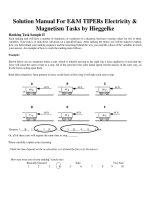GLAUCOMA GLAUCOMA Harold E Cross M D
Bạn đang xem bản rút gọn của tài liệu. Xem và tải ngay bản đầy đủ của tài liệu tại đây (6.27 MB, 55 trang )
GLAUCOMA
GLAUCOMA
Harold E. Cross M.D., Ph.D.
(With contributions by T. Altenbernd, MD, and P. Tsai, MD)
Brought to you by
GLAUCOMA
GLAUCOMA
What is it?
A disease of progressive optic
neuropathy with loss of retinal
neurons and their axons (nerve
fiber layer) resulting in blindness if
left untreated.
Brought to you by
GLAUCOMA
“Glaucoma describes a group of diseases that kill retinal
ganglion cells.”
“High IOP is the strongest known risk factor for glaucoma
but it is neither necessary nor sufficient to induce the
neuropathy.”
Libby, RT, et al: Annu Rev Genomics Hum Genet 6: 15, 2005 Brought
to you by
GLAUCOMA
GLAUCOMA
What causes it?
There is a dose-response
relationship between intraocular
pressure and the risk of damage to
the visual field.
Brought to you by
GLAUCOMA
GLAUCOMA
ADVANCED GLAUCOMA
INTERVENTION STUDY
Brought to you by
GLAUCOMA
GLAUCOMA
How do we diagnose it?
IOP is not helpful diagnostically until it reaches
approximately 40 mm Hg at which level the
likelihood of damage is significant.
Visual fields are also not helpful in the early stages
of diagnosis because a considerable number of neurons
must be lost before VF changes can be
detected.
Optic nerve damage in the early stages is difficult
or impossible to recognize.
50% of people with glaucoma do not know it!
Brought to you by
GLAUCOMA
GLAUCOMA
Intraocular pressure is not the only factor
responsible for glaucoma!
95% of people with elevated IOP will never have
the damage associated with glaucoma.
One-third of patients with glaucoma do not have
elevated IOP.
Most of the ocular findings that occur in people
with glaucoma also occur in people without
glaucoma.
Brought to you by
CHARACTERISTICS OF IOP
Normal
range: 10-22 mm Hg
Follows non-Gaussian curve with right
skewed tail
30-50% of open angle glaucoma patients
have IOP <22 mmHg
Diurnal flucuation normally < 6 mmHg
Women have slightly higher pressures
•
•
•
Brought to you by
GLAUCOMA
Anatomy of
anterior chamber
angle
Brought to you by
GLAUCOMA
Iris bombé
Brought to you by
GLAUCOMA
GLAUCOMA
Population distribution of IOP
Brought to you by
GLAUCOMA
GLAUCOMA
IOP Variables
Gender influences:
Normal vs glaucoma:
Brought to you by
GLAUCOMA
GLAUCOMA
Angle Anatomy
Brought to you by
GLAUCOMA
GLAUCOMA
How do we measure
IOP?
Applanation
Tonopen
Schiotz
Air
Non-contact
Brought to you by
GLAUCOMA
GLAUCOMA
Tonometry
Applanation
Schiotz
Brought to you by
GLAUCOMA
Goldmann applanation
tonometer
Brought to you by
GLAUCOMA
Tonopen
Brought to you by
GLAUCOMA
GLAUCOMA
Goldmann perimeter
Glaucoma visual fields
Brought to you by
GLAUCOMA
GLAUCOMA
The normal visual field: an island of
vision in a sea of darkness:
Brought to you by
THE VISUAL FIELD
Humphrey automated perimetry
Brought to you by
GLAUCOMA
Visual fields in glaucoma
Early
Late
Brought to you by
GLAUCOMA
GLAUCOMA
Cup-to-disk ratio
Brought to you by
GLAUCOMA
GLAUCOMA
DISK CUPPING
Normal
Glaucoma
Brought to you by
GLAUCOMA
GLAUCOMA
Glaucomatous cupping
Brought to you by
GLAUCOMA
GLAUCOMA
The histology of glaucomatous optic nerve
cupping:
Glaucomatous:
Normal:
Brought to you by









